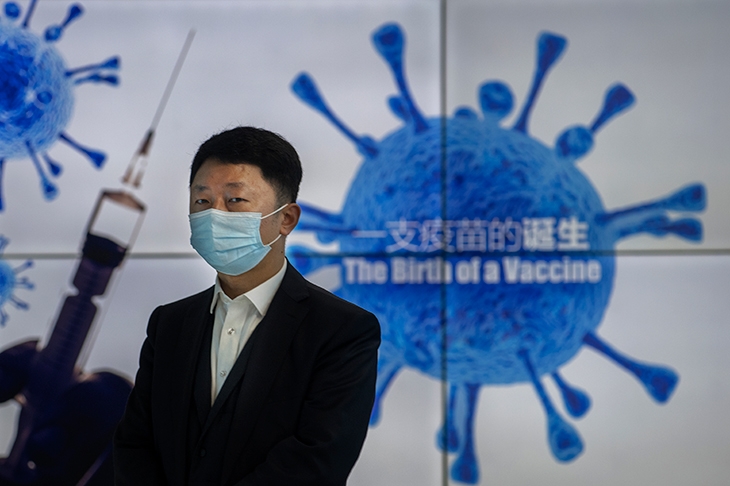At the start of the year Sebastián Piñera, president of Chile, went to Santiago airport personally to greet a consignment of vaccines from China. ‘Today is a day of joy, excitement and hope,’ he said from a podium on the tarmac. ‘As you see behind me, there is the plane that brought a shipment of almost two million doses of Sinovac vaccines.’ By April, Chile had suffered one of the worst COVID surges in Latin America. The joy and hope, it seemed, had been misplaced.
A few weeks ago, Chile’s government announced that, after a real-world study involving 10.5 million Chileans, Sinovac turned out to be only 16 percent effective at reducing the risk of infection after one shot and 67 percent effective two weeks after the second dose. Even Chile’s fast-paced vaccine program has not been enough to prevent a new wave and a new lockdown.
Chinese state media, such as China Daily, owned by the Propaganda Department of the Chinese Communist party, have tried to counter such bad news with boasts that China’s vaccines are ‘saving the world’ from COVID. Yet the more we learn about Sinovac the more dubious this claim becomes.
By April it became clear that the Pfizer and AstraZeneca vaccines were helping America, Britain, Israel and others to get on top of the outbreak, while countries that were relying on Chinese vaccines — such as Brazil, Chile, Turkey, Indonesia, Thailand and Malaysia — were struggling to do so. Gao Fu, head of the Chinese Center for Disease Control and Prevention, made what was, for a Chinese government official, an extraordinary admission. The three vaccines produced by the country so far, he said at a conference, ‘don’t have very high rates of protection’. While he later claimed he had been misinterpreted, it merely served to give the impression he had been told to shut up for admitting the truth.
It isn’t just a problem of vaccine efficacy; China’s own vaccination rollout began slowly. Even after a big push over the past couple of weeks China has delivered only 36 doses per 100 of the population, far fewer than Chile (90), the UK (90) and the US (86). It lags behind Germany, Italy and France, all of which suffered from the EU’s self-confessed inadequate procurement program.
China’s three vaccines (the first two developed by state-owned Sinopharm, one in association with the Beijing Institute of Biological Products and the other in association with the Wuhan Institute of Biological Products; the third vaccine is made by the private company Sinovac) all use dead SARS-CoV-2 viruses to stimulate the production of antibodies. Compared with European and American methods, this is an older and somewhat cruder way of making a vaccine. AstraZeneca, by contrast, uses a ‘viral vector’ — a common-cold virus from a chimpanzee — to deliver genes from the spike protein of the SARS-CoV-2 virus, not the whole virus. Pfizer and Moderna are novel messenger RNA vaccines, which work by effectively programming proteins to produce antibodies. Before the pandemic this was untested technology; now, thanks to impressive results, it is the future.
China was certainly quick out of the blocks in its vaccine diplomacy, which means many countries will be anxious about the products’ efficacy. Some 260 million doses of Chinese vaccines have been distributed worldwide, and Sinopharm scored a coup earlier this year when Hungary turned to it after growing frustration with the EU vaccine procurement scheme.
Much of the problem has been the slowness of Sinopharm and Sinovac to publish full data, while trials held abroad have shown very mixed results. For Sinopharm, the World Health Organization quoted an efficacy rate of 79 percent for preventing both symptomatic disease and hospital admissions. In the first respect that would put it on a par with AstraZeneca. In the latter respect it is rather below the performance of the western vaccines so far approved for use.
As for Sinovac, results have been all over the place. Brazilian trials at first suggested an efficacy against symptomatic illness of 78 percent — hastily downgraded to just 50.4 percent when mild cases were added. That is only just over the 50 percent threshold that the WHO, and many countries, demand for approval. Other trials have produced better outcomes: interim results from a Turkish study claimed 91 percent efficacy and a study involving Indonesian healthcare workers 65 percent.
Why are these results so different? One possibility is that different trials are using different standards to define symptomatic disease. Another is that production of the Sinovac vaccine itself is not constant: that different batches have very different results. That is one problem with producing dead-virus vaccines: the process of inactivating the live virus, either chemically or through the application of heat, can change the way the body reacts to it. But with a lack of good data from the company itself it is hard to tell. The biggest blot against Sinovac remains the real-world data from Chile.
To produce any vaccine within a year is an extraordinary achievement. Nevertheless, China’s pretense to scientific prowess over the West has been exposed by mixed and questionable results. Far worse is the dark cloud that will hang over China’s scientific reputation if it can be proved that the COVID pandemic began in the world’s most expensive ever laboratory experiment. On that, we can expect China to be even more evasive than over its vaccine trials.
This article was originally published in The Spectator’s UK magazine. Subscribe to the World edition here.


















